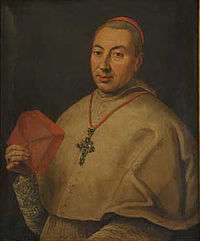Andrea Gioannetti
Andrea Gioannetti (1722–1800) was an Italian Roman Catholic bishop and cardinal.

Biography
Andrea Gioannetti was born in Bologna on 6 January 1722, the son of Baldassarre Francesco Gioannetti and Pellegrina Zanoni.[1] His baptismal name was Melchiorre Benedetto Lucidoro Gioannetti.[1]
In 1739, he joined the Order of Saint Benedict, Camaldolese at the monastery of Sant'Apollinare in Classe near Ravenna.[1] He adopted "Andrea" as his religious name on 29 June 1739.[1] He was then sent to study at Bertinoro and Rome, where he studied philosophy and theology.[1]
He was ordained as a priest on 19 December 1744.[1] After further studies in Bertinoro and Rome, Gioannetti returned to Bertinoro as its priest.[1] On 19 December 1748, he returned to the monastery at Classe, becoming lector of philosophy.[1] He later served as the theologian of Ferdinando Romoaldo Guiccioli, Archbishop of Ravenna, from 15 June 1753 until 1763.[1] In 1763, he became procurator and economous of the monastery of Classe, later becoming its abbot in 1770.[1] In 1773, he became abbot of the monastery of San Gregorio Magno al Celio in Rome.[1] In this capacity, he served under Cardinal Giovanni Angelo Braschi, the monastery's commendatory abbot, who became Pope Pius VI in February 1775.[1]
On 29 January 1776, he was elected titular bishop of Emeria and became administrator of the Archdiocese of Bologna.[1] He was consecrated as a bishop by Cardinal Giovanni Francesco Albani, Bishop of Ostia, at San Gregorio Magno al Celio on 4 February 1776.[1] He arrived in Bologna on 5 March and began a canonical visitation.[1] As head of the Papal Legation, he was also the secular administrator of Bologna.
In the consistory of 23 June 1777, Pope Pius VI made Gioannetti a cardinal in pectore.[1] This was published in the consistory of 15 December 1777, and Gioannetti received the red hat on 18 December 1777.[1] He was awarded the pallium and the titular church of Santa Pudenziana on 30 March 1778.[1]
In 1792, the Archdiocese of Bologna was overrun with Catholic priests fleeing the French Revolution.[1] Cardinal Gioannetti subsequently wrote denouncing the revolutionaries.[1] In June 1796, the French troops of Napoleon entered the Archdiocese of Bologna.[1] Over the next several years, Gioannetti worked to secure the position of Catholicism as the state religion, a position recognized in the March 1797 constitution of the Cispadane Republic, but Catholicism's favored position was reversed when the Cispadane Republic was merged with the Cisalpine Republic in July 1797.[1] In March 1799, Austrian and Russian troops occupied Bologna, enabling Gioannetti to reestablish his authority.[1]
He participated in the papal conclave of 1799–1800 that elected Pope Pius VII.[1] Shortly after returning to Bologna, he died on 8 April 1800.[1] He is buried in Bologna Cathedral.[1]
| Wikimedia Commons has media related to Andrea Gioannetti. |
Sources
- Andrea Giovannetti (1788). Synodus dioecesana Bononiensis ab eminentissimo et reverendissimo domino D. Andrea Joannetto ... celebrata diebus 2. 3. et 4. Septembris ann. 1788 (in Latin). Bologna: apud Longhi et a Vulpe impressores archiepiscopales.
- Luciano Meluzzi (1967). Gli arcivescovi di Bologna (in Italian). Bologna: Meluzzi. pp. 68–74.
| Catholic Church titles | ||
|---|---|---|
| Preceded by Vincenzo Malvezzi |
Archbishop of Bologna 1775–1800 |
Succeeded by Carlo Oppizoni |